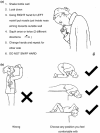BSACI guidelines for the management of allergic and non-allergic rhinitis
- PMID: 18081563
- PMCID: PMC7162111
- DOI: 10.1111/j.1365-2222.2007.02888.x
BSACI guidelines for the management of allergic and non-allergic rhinitis
Abstract
This guidance for the management of patients with allergic and non-allergic rhinitis has been prepared by the Standards of Care Committee (SOCC) of the British Society for Allergy and Clinical Immunology (BSACI). The guideline is based on evidence as well as on expert opinion and is for use by both adult physicians and paediatricians practicing in allergy. The recommendations are evidence graded. During the development of these guidelines, all BSACI members were included in the consultation process using a web-based system. Their comments and suggestions were carefully considered by the SOCC. Where evidence was lacking, consensus was reached by the experts on the committee. Included in this guideline are clinical classification of rhinitis, aetiology, diagnosis, investigations and management including subcutaneous and sublingual immunotherapy. There are also special sections for children, co-morbid associations and pregnancy. Finally, we have made recommendations for potential areas of future research.
Figures




References
-
- Laforest L, Bousquet J, Pietri G et al Quality of life during pollen season in patients with seasonal allergic rhinitis with or without asthma. Int Arch Allergy Immunol 2005; 136:281–6. - PubMed
-
- Blaiss MS. Allergic rhinitis and impairment issues in schoolchildren: a consensus report. Curr Med Res Opin 2004; 20:1937–52. - PubMed
-
- Cockburn IM, Bailit HL, Berndt ER, Finkelstein SN. Loss of work productivity due to illness and medical treatment. J Occup Environ Med 1999; 41:948–53. - PubMed
-
- Blaiss MS. Cognitive, social, and economic costs of allergic rhinitis. Allergy Asthma Proc 2000; 21:7–13. - PubMed
-
- Slavin RG. Complications of allergic rhinitis: implications for sinusitis and asthma. J Allergy Clin Immunol 1998; 101:S357–60. - PubMed
Publication types
MeSH terms
Substances
Grants and funding
LinkOut - more resources
Full Text Sources
Medical

